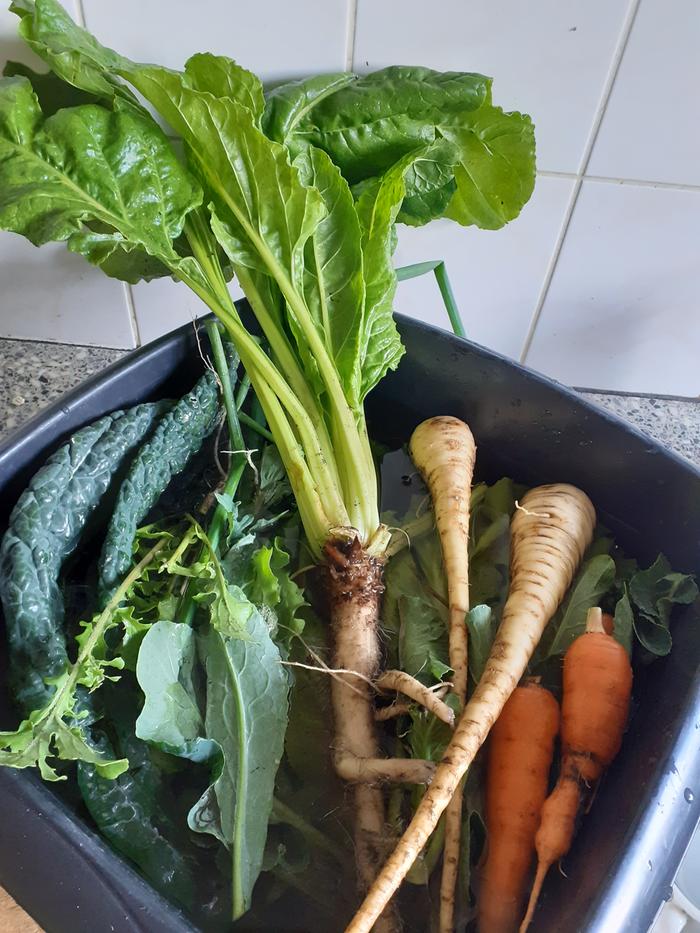
 24
24




 10
10




Invasive plants are Earth's way of insisting we notice her medicines. Stephen Herrod Buhner
Everyone learns what works by learning what doesn't work. Stephen Herrod Buhner

 14
14




 12
12




Anne Miller wrote:I have not grown sunchokes because some folks say they cause gas.
 12
12




Christopher Weeks wrote:Where I live, mustard doesn't provide as much leaf as kale, but reseeds way, way better. So even though it's less efficient at producing food-mass, it might be a better pump.
Are walking onions especially more productive than potato onions?

 13
13




- Tim's Homestead Journal - Purchase a copy of Building a Better World in Your Backyard - Purchase 6 Decks of Permaculture Cards -
- Purchase 12x Decks of Permaculture Cards - Purchase a copy of the SKIP Book - Purchase 12x copies of Building a Better World in your Backyard

 19
19





Tradition is not the worship of ashes, but the preservation of fire.
 12
12




 8
8




 13
13




Visit Redhawk's soil series: https://permies.com/wiki/redhawk-soil
How permies.com works: https://permies.com/wiki/34193/permies-works-links-threads
 12
12





 8
8




How Permies works: https://permies.com/wiki/34193/permies-works-links-threads
My projects on Skye: The tree field, Growing and landracing, perennial polycultures, "Don't dream it - be it! "
 1
1
















 7
7





How Permies works: https://permies.com/wiki/34193/permies-works-links-threads
My projects on Skye: The tree field, Growing and landracing, perennial polycultures, "Don't dream it - be it! "
 8
8




 9
9




paul wheaton wrote: strawberries that spread prolifically
Visit Redhawk's soil series: https://permies.com/wiki/redhawk-soil
How permies.com works: https://permies.com/wiki/34193/permies-works-links-threads












 8
8




paul wheaton wrote:
skirret (tastes like carrots, but spreads itself and can be harvested in winter)
parsnips (can be harvested in winter)

How Permies works: https://permies.com/wiki/34193/permies-works-links-threads
My projects on Skye: The tree field, Growing and landracing, perennial polycultures, "Don't dream it - be it! "
 11
11




 7
7
















 8
8




How Permies works: https://permies.com/wiki/34193/permies-works-links-threads
My projects on Skye: The tree field, Growing and landracing, perennial polycultures, "Don't dream it - be it! "
 8
8




 5
5








Anne Miller wrote:
I have not grown sunchokes because some folks say they cause gas.
Lif Strand
New Mexico USA
 4
4




Lif Strand wrote:
Anne Miller wrote:
I have not grown sunchokes because some folks say they cause gas.
That's not a problem if you cook them.
How permies.com works
What is a Mother Tree ?












 7
7




Kathleen Sanderson wrote:The sunchokes would probably grow just fine, but I suspect my daughter (adult, handicapped) can't eat them. Most plant foods seem to trigger extreme gut problems for her...Daughter tolerates sauerkraut well (and dill pickles); it seems likely that kale could be made into sauerkraut...
 10
10




 4
4




Christopher Weeks wrote:
Kathleen Sanderson wrote:The sunchokes would probably grow just fine, but I suspect my daughter (adult, handicapped) can't eat them. Most plant foods seem to trigger extreme gut problems for her...Daughter tolerates sauerkraut well (and dill pickles); it seems likely that kale could be made into sauerkraut...
It might be worth trying fermented sunroots. There's some chance that the fermentation is what's making hard to handle veggies work, and if it worked for these, you might have a staple.
 8
8




row row row your boat, gently down the stream
merrily merrily merrily, merrily, life is but a dream.
 8
8




 4
4




Cassie Martin wrote:I don't know if they do this everywhere, but potatoes are tenacious where I live. If you miss just one or two little potatoes, they grow big, healthy plants next year. There are potatoes growing in the lawn areas where we had garden beds years ago. They could hypothetically be harvested any time, you would just need to know where they were in the winter.
 7
7




paul wheaton wrote:
Anne Miller wrote:I have not grown sunchokes because some folks say they cause gas.
I have heard the same thing. And I have learned three very important things:
THING-1: I have eaten sunchokes about 50 times and had gas only once. But it was sooooo good, I ate way, way, way more than i should have.
THING-2: my understanding is that you need to build up the ability to thoroughly digest sunchokes. Start small.
THING-3: apparently, if you harvest after the first hard frost, there will be less digestive issues.
The holy trinity of wholesomeness: Fred Rogers - be kind to others; Steve Irwin - be kind to animals; Bob Ross - be kind to yourself




James Bradford wrote:Oyster mushrooms do great here in the winter, but you gotta figure out how to create a consistent cool, moist, oxygenated place for them ...I kinda cheat and use big plastic buckets, but definitely a great source of easy calories.
Lif Strand
New Mexico USA
 10
10




 8
8




 6
6




L Anderson wrote: I’m not going to pay attention to stuff I don’t like in it (like kale, or making my own biochar).
I’m going to pay attention to the parts that get me thinking of possibilities I hadn’t thought of.
Lif Strand
New Mexico USA
 5
5




 7
7




 3
3




 10
10




L Anderson wrote:...
Hence, my question: how to define staple crops?
...
Bottom line: my staple crops will be:
1. those which provide the greatest variety of vitamins and minerals and antioxidants and all that other good stuff that others take pills for but I’d rather get from my food. So: maximize variety for good nutrition.
2. Those that I can find space for, or create space for, that I can manage (physically) while aging in place.
3. Those that are good for the ground and the air and help support birds and bees etc. And don’t require crazy amounts of water (it no longer rains here in summer), and can tolerate ever increasing heat.
...
Thank you, Paul.

"Also, just as you want men to do to you, do the same way to them" (Luke 6:31)

|
look! it's a bird! it's a plane! It's .... a teeny tiny ad
Freaky Cheap Heat - 2 hour movie - HD streaming
https://permies.com/wiki/238453/Freaky-Cheap-Heat-hour-movie
|





